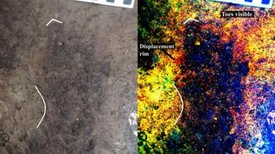Several feet below a beach in British Columbia, archaeologists discovered soil trampled by human feet—the oldest footprints found so far in North America. Christopher Intagliata reports.
在不列颠哥伦比亚省的海滩下面几英尺的地方,考古学家发现了被人类踩踏的土壤,这是迄今为止在北美发现的最古老的脚印。克里斯托弗·因塔利亚塔报道。
撰文\播音:克里斯托弗·因塔利亚塔(Christopher Intagliata)
翻译:邱燕宁
审校:杨枭
During the last ice age, the northern half of North America was blanketed by ice. But along the Pacific coast of Canada, some land remained bare…a place where animals and plants could thrive. And humans too.
在上一个冰河时期,北美的北部地区被冰覆盖。但是在加拿大的太平洋沿岸,一些土地仍然光秃秃的,那里是动植物和人类茁壮成长的地方。
Archaeologists have found stone tools and cave sites 12,000 to 13,000 years old in the coastal Pacific Northwest. One find was a mastodon rib with a bony weapon in it. And now scientists at the Hakai Institute and the University of Victoria have made a spectacular discovery: clay soil, trampled by human feet—the oldest footprints uncovered in North America.
考古学家在太平洋西北部沿岸发现了1.2万至1.3万年前的石器和洞穴遗址。其中发现的一根乳齿象肋骨,里面有一根骨头武器。现在,哈凯研究所和维多利亚大学的科学家们有了一个惊人的发现: 被人类踩踏过的粘土——这是北美发现的最古老的脚印。
Researchers were digging several feet below a modern-day beach on British Columbia's Calvert Island, about 250 miles northwest of Vancouver, when they discovered tracks. They found 29 in all. Some had toes, arches and heel prints—indicating the people who left them were probably barefoot. And using a shoe size measurement chart—like the ones you find in a shoe store—they determined that the footprints likely belonged to a child and two adults. Who lived and walked the area some 13,000 years ago.
在温哥华西北约250英里的不列颠哥伦比亚卡尔弗特岛,研究人员把现今的海滩向下挖掘了几英尺,在这里发现了踪迹。他们总共找到了29个脚印,有脚趾印、足弓印和脚跟印,表明离开的人可能是赤脚的。通过使用鞋尺寸测量图表,就像你在鞋店做的那样,他们确定这些脚印可能属于一个孩子和两个成年人。大约13000年前,他们在这个地区生活和行走。
The results are in the journal PLOS ONE. [Duncan McLaren et al., Terminal Pleistocene epoch human footprints from the Pacific coast of Canada]
这些结果发表在PLOS ONE上。
The tracks are not in a line, like the famous Laetoli footprints in Tanzania. Instead, they're facing different directions, suggestive of people gathering. Or perhaps, the authors write, they could be the footprints of people getting out of a boat, headed towards higher and drier land. Still on the move.
这些脚印不在一条直线上,就像坦桑尼亚著名的莱托利(Laetoli)脚印那样。相反,他们朝着着不同的方向,表明这些人可能在聚会,或者,像作者写的那样,它们可能是人们走出小船,朝着更高、更干燥的土地前进的足迹。他们仍然在移动。

 京公网安备11010502039775号
京公网安备11010502039775号  京公网安备11010502039775号
京公网安备11010502039775号 
















